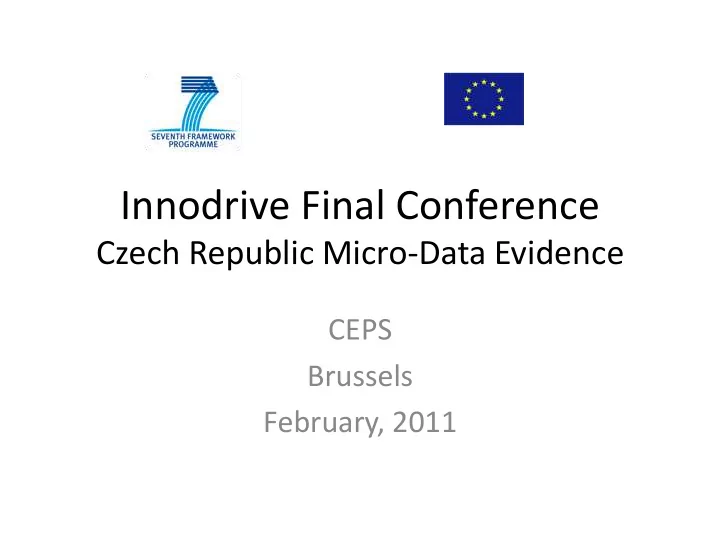

Innodrive Final Conference Czech Republic Micro-Data Evidence CEPS Brussels February, 2011
Two Czech Studies 1. NUTS4-level study of regional divergence in human capital and of HC productivity spillovers. 2. Firm-level investigation of relative wages and productivity of organizational workers. Both approaches use the historical location of college education for identification.
1. Czech Districts and Colleges • Extensive inherited NUTS-4 inequality in HC endowment (share of college educated). • We find that more educated areas increase share of college educated faster and feature higher (not lower) returns to education and attract more FDI. Are there HC spillovers? • Using historical location of colleges, there is no evidence for spillovers outside the two main agglomerations (Prague and Brno).
2. Czech Organizational Intangibles • Based on aggregate data Jona-Lasinio and Iommi (2010) suggest that the Czech Republic, Slovakia and Hungary have the highest growth in the EU in the share of intangibles in GDP and the highest impact of intangibles on labor productivity growth during 1995 to 2005. `Organizational capital' is responsible for almost a third of the ‘new’ intangibles. • No micro-data evidence up to now. Little work on organization structure or executive comp.
Data • LEED data (Structure of Earnings Survey) provides wages, ISCO-4 occupational classification (employment structure), and NUTS-4 location. • Commercial balance sheet data (Czech Amadeus source) give assets and performance indicators (value added & staff costs). • We added hand-collected indicators of FDI type. Merged LEED-Balance sheet data for 1999-2006 allow us to measure the effects of organizational employment on performance.
The usual regressions Org it log VA it b 0 b 1 log L it b 2 L it b 4 log RND it b 5 log FA it it + industry_year dummies. In a specification controlling for general human capital, we find organizational workers to be about 50% more productive (and to be fairly rewarded for their value in terms of wages).
Endogeneity of org. share input: • The denominator (employment or hours) may be posit. correlated with productivity shocks or measured with error => possible downward bias • Exogenous source of variation in inputs? We rely on the historical location of college education across NUTS-4. Only cross-section variation. • The conclusion of equal relative productivity and pay of organizational workers is not affected. • It is also robust to several robustness checks.
FDI We also study organizational intangibles in foreign-owned greenfields and takeovers, which are more productive than domestic firms. • The share of organizational workers is almost a third higher in foreign-owned greenfields (controlling for industry, size, location, R&D). • Relative productivity of organizational workers is at least twice as high in foreign-owned firms. • Consistent with case studies of FDI practices.
Recommend
More recommend